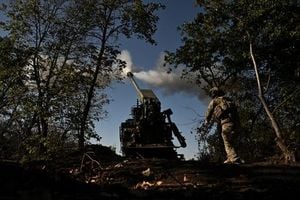On September 17, 2025, Denmark’s political landscape shifted in a way few could have predicted just a few years ago. Standing before a packed press conference in Copenhagen, Prime Minister Mette Frederiksen declared, “For the first time, Denmark is to build up military capacity in the form of long-range precision weapons.” With those words, Denmark signaled a dramatic departure from its traditional defense posture, one that has long prioritized defensive systems over offensive reach.
This move, described by Frederiksen as a “paradigm shift in Danish defense policy,” comes amid growing anxiety in Europe over Russia’s intentions and capabilities. Since Russia’s full-scale invasion of Ukraine in February 2022, the sense of security that once prevailed in many European capitals has been replaced by a more urgent focus on deterrence and readiness. Denmark, it seems, is no exception.
Frederiksen minced no words about the rationale behind the decision. “Russia would constitute a threat to Denmark and Europe for years to come,” she told reporters, emphasizing that the new weapons would create a “credible deterrence.” According to AFP and Euractiv, the prime minister explained, “With these weapons, the defense forces will be able to hit targets at long range and, for example, neutralize enemy missile threats.” The specifics—whether the arsenal will be made up of missiles, drones, or some combination—are still being decided. But the intent is clear: Denmark wants to be able to strike back if threatened.
Defense Minister Troels Lund Poulsen, who appeared alongside Frederiksen and Foreign Minister Lars Løkke Rasmussen at the hastily called news conference, echoed this sentiment. As reported by Al Jazeera, Poulsen said the government would seek to build up both missiles and drones, though he stopped short of naming the exact systems under consideration. The Ministry of Defense, for its part, has been tasked with evaluating which long-range weapons best fit Denmark’s needs—a process that is already underway.
The announcement comes hot on the heels of Denmark’s largest ever arms purchase. Just last week, the government committed 58 billion kroner (about $9.2 billion or €7.7 billion) to acquire European-made air and missile defense systems, a deal that dwarfs previous military procurements. And this is only part of a broader rearmament effort: in February 2025, Frederiksen urged the Danish military to “buy, buy, buy,” promising an additional 50 billion kroner (roughly $7.9 billion or €6.7 billion) in defense spending over the next two years. These moves mark a sharp reversal after decades of defense budget cuts and a longstanding emphasis on peacekeeping over power projection.
Not everyone is pleased with Denmark’s new direction. Vladimir Barbin, Russia’s ambassador to Denmark, lashed out at the announcement, calling it “pure madness.” In a written statement posted on Telegram and quoted by AFP, Barbin warned, “No one, anywhere, ever in the world has considered threatening a nuclear power publicly. These statements will undoubtedly be taken into account.” He went further, suggesting that Denmark is now “not only considering the possibility of a direct military confrontation with Russia, but is also preparing for such a scenario.”
Frederiksen, however, was quick to push back against what she saw as thinly veiled threats. Speaking to Danish broadcaster DR, she said the ambassador’s comments should be interpreted as an attempt at intimidation. “Russia is trying to threaten Europe and NATO into not defending our people and borders. Of course, we will not be intimidated,” she asserted. The prime minister’s firm stance underscores a broader shift in Danish—and indeed European—attitudes: the era of assuming that geography and diplomacy alone would keep the country safe is over.
Denmark’s decision to invest in long-range precision weapons is not occurring in a vacuum. Across the continent, governments are reassessing their military capabilities in light of the war in Ukraine and Russia’s increasingly aggressive posture. According to Al Jazeera, Ukrainian President Volodymyr Zelenskyy announced that Ukraine expects to receive about $3.5 to $3.6 billion in Western arms through the Priority Ukraine Requirements List (PURL) initiative by October 2025, with air defense systems among the first shipments. The fighting in Ukraine, especially the relentless Russian drone and missile attacks—more than 3,500 drones and nearly 190 missiles launched in September alone, according to Zelenskyy—serves as a grim reminder of the stakes involved.
Frederiksen and her government have made clear that, while Denmark’s new long-range weapons will enhance its ability to strike distant targets, the overarching goal remains to avoid war. “The goal remains to avoid war,” she reiterated at the news conference, as reported by Bloomberg. But, she added, credible deterrence is the best way to ensure peace. The logic is straightforward: if Denmark can convincingly threaten to strike back, potential adversaries may think twice before making any aggressive moves.
The context for Denmark’s rearmament is not limited to Russia’s actions in Ukraine. Tensions with other global powers have also played a role. Frederiksen has been outspoken in rebuffing United States President Donald Trump’s repeated suggestions about acquiring Greenland, a semi-autonomous Danish territory. Just last month, Denmark summoned the US’s charge d’affaires after reports surfaced that Americans had covertly tried to sway Greenlanders against Denmark. “Any interference in internal affairs in the kingdom of Denmark and Greenlandic democracy is unacceptable,” Frederiksen said, according to Al Jazeera. While the immediate focus is on Russia, the broader message is one of vigilance and sovereignty.
Denmark’s new approach to defense has not emerged overnight. Since the Russian invasion of Ukraine, there has been a growing consensus across the political spectrum that the country can no longer afford to take its security for granted. Rearmament has become a top priority for Frederiksen’s Social Democratic government, a notable shift for a party and a country once seen as champions of international cooperation and arms control. The decisions to invest in advanced air defense systems and now to pursue long-range precision weapons are both practical responses to a changed security environment and symbolic gestures meant to reassure Danes and their allies that the country is ready to meet new challenges head-on.
Still, uncertainty remains. The exact types of weapons Denmark will acquire have yet to be determined, and it is not immediately clear how much the country will ultimately spend on these new capabilities. What is clear, however, is that Denmark’s days of relying solely on defensive systems are over. The country is entering a new era—one in which it aims to deter threats not just by defending its own borders, but by possessing the means to strike back if necessary.
As Denmark embarks on this new path, the rest of Europe is watching closely. The decisions made in Copenhagen may well set a precedent for other small and mid-sized nations grappling with the realities of a more dangerous world. For now, though, Denmark’s leaders are betting that a credible show of strength is the surest way to keep the peace.





